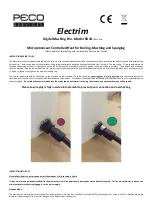
SLC 500 Thermocouple/mV Analog Input Module
17
Publication 1746-5.23
Cable Wiring Considerations
Follow these guidelines to wire your input signal cables:
• Power, input, and output (I/O) wiring must be in accordance with Class 1,
Division 2 wiring methods [Article 501-4(b) of the National Electrical
Code, NFPA 70] and in accordance with the authority having jurisdiction.
• Route the field wiring away from any other wiring and as far as possible
from sources of electrical noise, such as motors, transformers, contactors,
and ac devices. As a general rule, allow at least 15.2 cm (6 in.) of separation
for every 120 V of power.
• Routing the field wiring in a grounded conduit can reduce electrical noise
further.
• If the field wiring must cross ac or power cables, ensure that they cross at
right angles.
• To limit the pickup of electrical noise, keep thermocouple and millivolt
signal wires as far from power and load lines as possible.
• For high immunity to electrical noise, use Belden™ 8761 (shielded, twisted
pair) or equivalent wire for millivolt sensors; you can also use shielded,
twisted pair thermocouple extension lead wire specified by the
thermocouple manufacturer. Using the incorrect type of thermocouple
extension wire or not following the correct polarity may cause invalid
readings.
• Ground the shield drain wire at only one end of the cable. The preferred
location is at the shield connections on the terminal block. (Refer to IEEE
Std. 518, Section 6.4.2.7 or contact your sensor manufacturer for additional
details.)
• Keep all unshielded wires as short as possible.
• Excessive tightening can strip a screw. Tighten screws no more than
0.25 Nm.
• Follow system grounding and wiring guidelines found in your SLC 500
Installation and Operation Manual.
Spare Allen-Bradley Parts








































